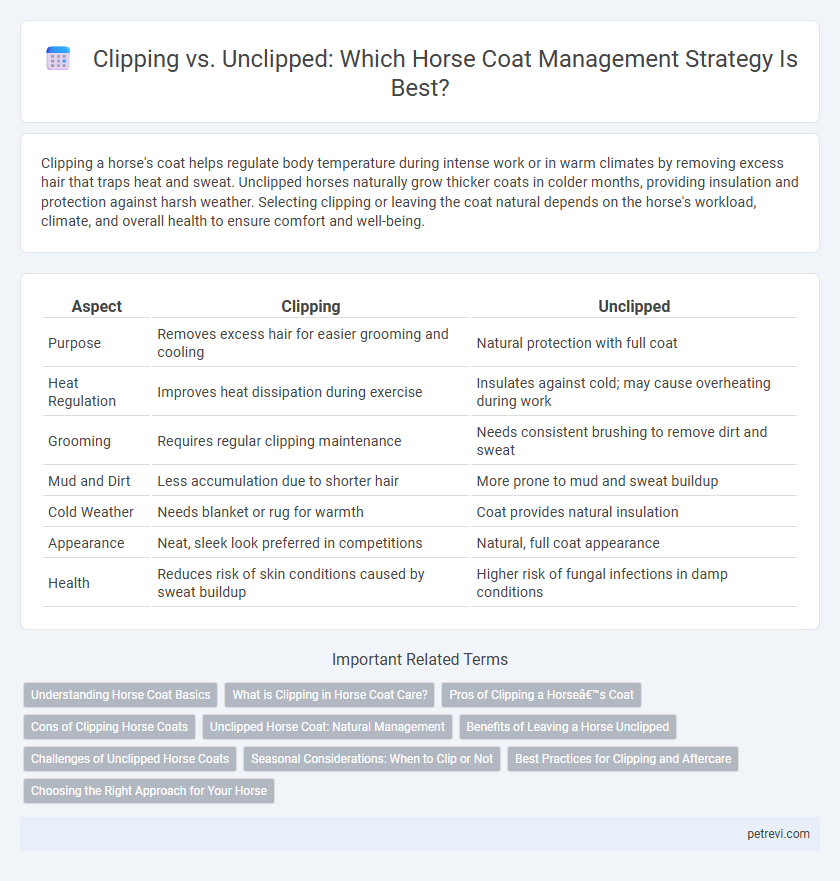Clipping a horse's coat helps regulate body temperature during intense work or in warm climates by removing excess hair that traps heat and sweat. Unclipped horses naturally grow thicker coats in colder months, providing insulation and protection against harsh weather. Selecting clipping or leaving the coat natural depends on the horse's workload, climate, and overall health to ensure comfort and well-being.
Table of Comparison
| Aspect | Clipping | Unclipped |
|---|---|---|
| Purpose | Removes excess hair for easier grooming and cooling | Natural protection with full coat |
| Heat Regulation | Improves heat dissipation during exercise | Insulates against cold; may cause overheating during work |
| Grooming | Requires regular clipping maintenance | Needs consistent brushing to remove dirt and sweat |
| Mud and Dirt | Less accumulation due to shorter hair | More prone to mud and sweat buildup |
| Cold Weather | Needs blanket or rug for warmth | Coat provides natural insulation |
| Appearance | Neat, sleek look preferred in competitions | Natural, full coat appearance |
| Health | Reduces risk of skin conditions caused by sweat buildup | Higher risk of fungal infections in damp conditions |
Understanding Horse Coat Basics
Horse coat management involves deciding between clipping and leaving the coat unclipped based on the animal's natural insulation and shedding patterns. Clipping removes the winter coat, helping horses stay cooler during intense exercise in colder months but requires blankets for warmth to prevent chills. Unclipped horses retain their natural coat, which provides protection and temperature regulation but may lead to overheating and prolonged drying times after work.
What is Clipping in Horse Coat Care?
Clipping in horse coat care involves trimming or shaving the horse's hair to manage its coat length, especially during colder months or heavy work periods. This practice helps prevent excessive sweating, allows for quicker drying after exercise, and reduces the risk of skin infections. Clipping techniques vary from trace clipping, which targets specific areas, to full body clipping for comprehensive coat management.
Pros of Clipping a Horse’s Coat
Clipping a horse's coat improves sweat management by allowing quicker drying, reducing the risk of skin infections and chills during exercise. It enhances the horse's comfort by preventing overheating and minimizing grooming time, especially in active or performance horses. Clipped coats also facilitate easier application of therapeutic treatments and improve the overall appearance for shows and competitions.
Cons of Clipping Horse Coats
Clipping horse coats can lead to increased sensitivity to cold temperatures, requiring additional blanketing and vigilant management to prevent chills and respiratory issues. The natural protection of the horse's coat is reduced, increasing vulnerability to skin irritations and potential sunburn. Horses clipped regularly may also suffer from coat regrowth discrepancies, which can cause uneven patches and discomfort during the transition period.
Unclipped Horse Coat: Natural Management
An unclipped horse coat provides natural insulation, helping regulate body temperature through seasonal changes without artificial alteration. The thick, unshorn hair offers protection against cold weather and precipitation while maintaining moisture balance essential for skin health. Managing an unclipped coat includes regular grooming to remove dirt, sweat, and debris, promoting natural shedding and preserving the horse's natural thermal regulation.
Benefits of Leaving a Horse Unclipped
Leaving a horse unclipped preserves its natural insulating coat, providing superior warmth and protection against harsh weather conditions and environmental stressors. The intact hair coat supports moisture-wicking and helps maintain the horse's natural oil balance, promoting healthier skin and reducing the risk of irritation or infection. Horses left unclipped generally require less maintenance, as their natural thermoregulation reduces the need for frequent blanketing and grooming adjustments.
Challenges of Unclipped Horse Coats
Unclipped horse coats pose significant challenges, including prolonged drying times after exercise, which can increase the risk of chills and respiratory issues. Thick winter coats trap sweat and moisture, leading to skin irritation and potential infections if not properly managed. Managing these coats requires careful grooming and longer drying periods to maintain the horse's health and comfort throughout colder months.
Seasonal Considerations: When to Clip or Not
Clipping a horse's coat is recommended during late fall or early winter to prevent overheating during indoor training sessions while maintaining enough natural insulation for outdoor conditions. Unclipped horses develop a thicker winter coat that provides essential warmth and protection from harsh weather but may require increased grooming to manage mud and sweat. Timing of clipping should align with the horse's workload, climate severity, and stable environment to optimize comfort and health.
Best Practices for Clipping and Aftercare
Clipping a horse's coat helps regulate body temperature and improve saddle fit, especially during heavy work or cold weather, while leaving a natural coat supports insulation and moisture regulation. Best practices for clipping include using sharp, clean blades to avoid skin irritation and clipping after exercise to ensure the horse is dry, which prevents fungal infections. Aftercare involves moisturizing the skin with horse-safe products, regular grooming to remove dirt, and providing adequate blanketing to maintain warmth and protect the newly clipped coat.
Choosing the Right Approach for Your Horse
Choosing between clipping and leaving your horse's coat unclipped depends on factors such as climate, workload, and horse temperament. Clipping helps manage sweat and promotes faster drying during frequent exercise, reducing the risk of skin issues, while leaving the coat natural preserves warmth in cold conditions. Assessing your horse's specific needs and environmental conditions ensures optimal coat management and overall health.
Clipping vs Unclipped for Horse Coat Management Infographic

 petrevi.com
petrevi.com